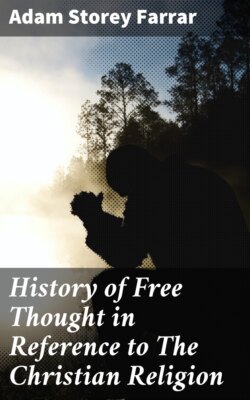Читать книгу History of Free Thought in Reference to The Christian Religion - Adam Storey Farrar - Страница 10
На сайте Литреса книга снята с продажи.
Lecture VII.
ОглавлениеTable of Contents
Free Thought in Germany subsequently to 1835; and in France during the present century.
Free Thought in Germany (continued).—History of the transition from Period II. named in the last lecture, to Period III. (pp. 262–274.)
Explanation of the attempt, noticed pp. 242, 259, of the Hegelian school to find a philosophy of Christianity. Critical remarks on Hegel's system, (pp. 263–267−267); its tendency to create an “ideological” spirit in religion (p. 264):—the school which it at first formed is seen best in Marheinecke. (p. 265.)
The circumstance which created an epoch in German theology was the publication of Strauss's Leben Jesu in 1835 (p. 266). Description of it (α) in its critical aspect (pp. 267, 270), which leads to an explanation of the previous discussions in Germany concerning the origin and credibility of the Gospels (pp. 268, 269); and (β) in its philosophical, as related to Hegel (p. 270); together with an analysis of the work (p. 271). Statement of the effects produced by it on the various theological parties. (pp. 272, 273.)
Period III. As the result of the agitation caused by Strauss's work, four theological tendencies are seen; viz.
(1) One external to the church, thoroughly antichristian, as in Bruno Bauer, Feuerbach, and Stirner. (pp. 274–276.) (2) The historico-critical school of Tübingen, founded by Chr. Bauer. (pp. 277–279.) (3) The “mediation” school, seen in Dorner and Rothe, (pp. 279–282.) (4) A return to the Lutheran orthodoxy, (pp. 282–285,) at first partly created by an attempt to unite the Lutheran and Reformed churches, (p. 282); seen in the “Neo-Lutheranism” of Hengstenberg and Hävernick, (p. 282), and the “Hyper-Lutheranism” [pg xl] of Stahl and the younger members of the school. (pp. 283, 285.)
Mention of the contemporaneous increase of spiritual life in Germany. (p. 285.)
Concluding estimate of the whole movement, (pp. 286, 287); and lessons for students in reference to it. (pp. 288, 289.)
Free Thought in France during the present century (pp. 290−305), (continued from Lect. IV. p. 194.)
In its tone it is constructive of belief, if compared with that of the eighteenth century.
From 1800–1852.
The speculative thought has exhibited four distinct forms. (p. 290.)
(1) The ideology of De Tracy, in the early part of the century. (2) The theological school of De Maistre, &c. to re-establish the dogmatic authority of the Romish church. (3) Socialist philosophy, St. Simon, Fourier, Comte. (4) The Eclectic school (Cousin, &c.)
Remarks on the first school.—The recovery of French philosophy and thought from the ideas of this school, partly due to the literary tone of Chateaubriand. (pp. 290, 291.)
Influence of the Revolution of 1830 in giving a stimulus to thought. (p. 291.)
Remarks on the third school.—Explanation of socialism as taught by St. Simon (pp. 292, 293); as taught by Fourier (pp. 293, 294); and difference from English socialism. (p. 294.)
Positivism, both as an offshoot of the last school, and in itself as a religion and a philosophy. (pp. 295, 296.)
Remarks on the fourth school.—Eclecticism as taught by Cousin, viewed as a philosophy and a religion. (pp. 297–299.)
Remarks on the second school; viewed as an attempt to refute the preceding schools. (p. 300.)
From 1852–1862.
New form of eclecticism under the empire (p. 302), viz. the historic method, based on Hegel, as Cousin's was based on Schelling.—E. Renan the type. (pp. 302−304.)
Free thought in the Protestant church (pp. 304, 305) regarded as an attempt to meet by concession doubts of contemporaries.
